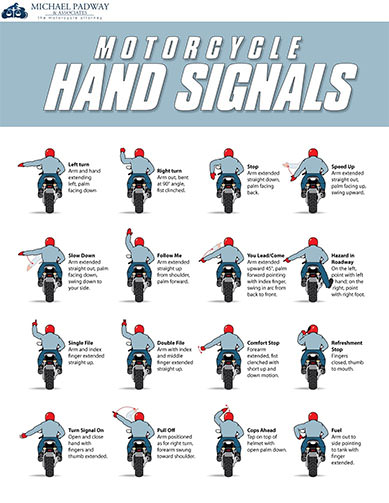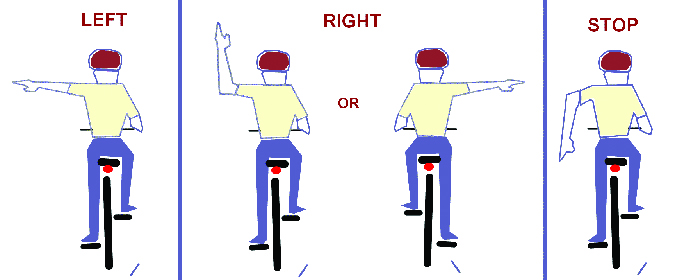
This indicates that the road captain wants the group in a single file formation, usually for safety reasons (example below). Single file - Position your left hand over your helmet with your fingers extended upward. Stop - Extend your left arm at a 45 degree angle with the palm of your hand facing back towards the riders behind you (example below). Slow down - Extend your left arm at a 45 degree angle and move your hand up and down (example below). Hazard to right (Side of road) - Extend your left arm upward at a 45 degree angle with your elbow bent to 90 degrees and point towards the hazard over your helmet (example below). Hazard to right (Lane of travel) - Extend your right leg at a 45 degree downward angle to indicate the hazard (example below). Hazard to left - Extend your left arm at a 45 degree downward angle and point towards the hazard (example below). Right Turn signal - Raise your left arm horizontal with your elbow bent 90 degrees vertically (example below). Left Turn signal - Raise your left arm horizontal with your elbow fully extended (example below). Howie at or 41 or Adam Wagman at or 41.Start your engines - With your left or right arm extended, move your index finger in a circular motion (example below).
HAND SIGNALS FOR DRIVING DRIVERS
In our next blog post, we will cover safety tips for motor vehicle drivers who share the road with cyclists, including the basic hand signals used by avid cyclist to communicate with others on the road.įor more information, please contact personal injury lawyers James R.

We are both avid cyclists and participate in the yearly Ride to Conquer Cancer – a two-day cycling event spanning over 200 kilometres throughout Ontario’s picturesque countryside. No cyclist wants to accept the “door prize.” Always be sure to scan for cyclists and check your mirror before opening a car door.

When turning right, a cyclist may either extend their left arm out horizontally with their hand and forearm raised upward or, alternatively, extend their right arm our horizontally to the side of the bicycle.If a cyclist extends their left arm horizontally to the side of the bicycle, they are making a left-hand turn.Not only will they alert you to actions a cyclist is about to take, but you can also use them in an emergency if your own signals and lights have failed. As a motor vehicle driver, you should become well-acquainted with these signals. Instead, they must use hand signals to alert others on the road about their plans. In their absence, we must react quickly and defensively.Ĭyclists don’t have the luxury of flipping a switch to signal a turn or to let others know they are slowing down. Seeing these lights in advance allow us to prepare for some of the important actions other vehicles are about to take. Experienced drivers should instinctively activate turn signals when making a turn, and any vehicle without working break lights (or signals) is a real hazard on the road.
HAND SIGNALS FOR DRIVING DRIVER
If you’ve ever encountered another motor vehicle driver who doesn’t signal when turning or whose break lights aren’t working, you’ll know how frustrating and dangerous this can be.


 0 kommentar(er)
0 kommentar(er)
